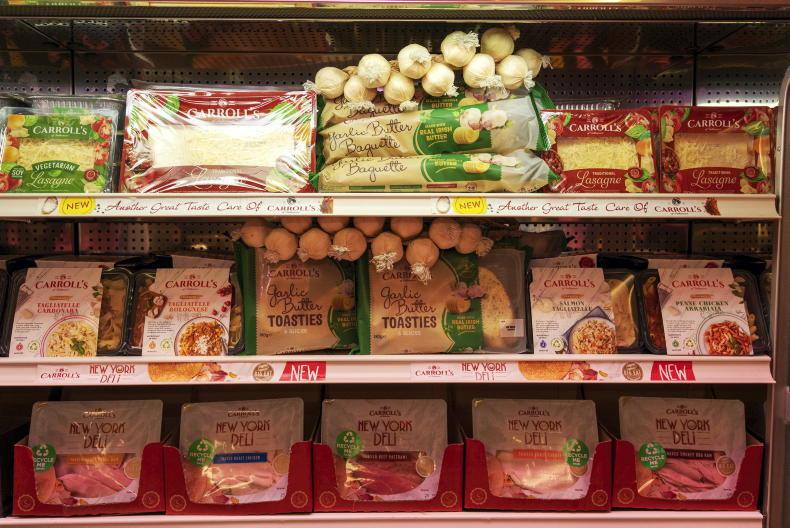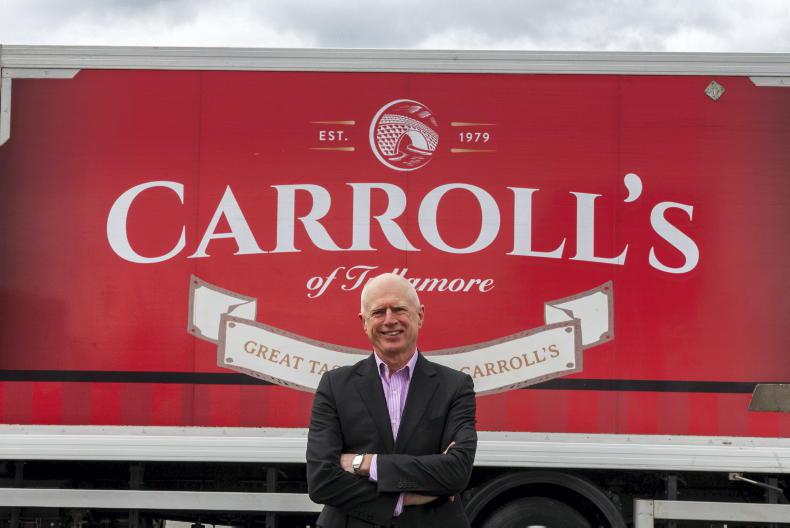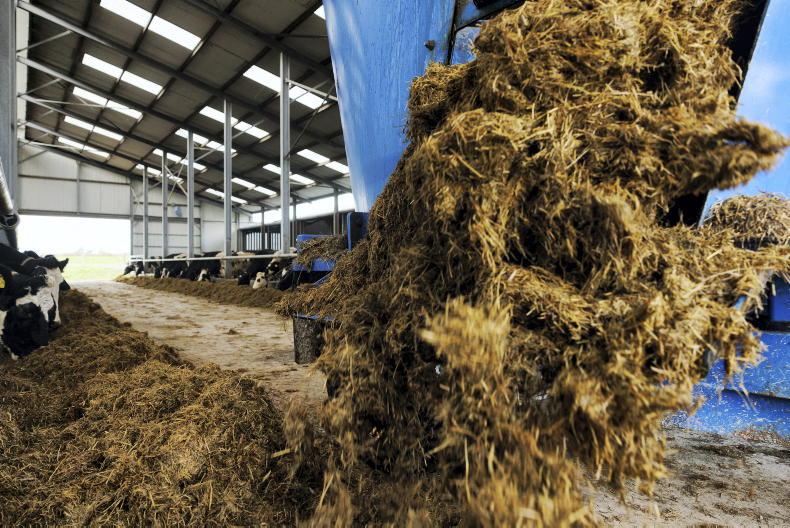Carroll’s Cuisine is arguably one of Ireland’s most successful consumer food brands, having stood the test of time for the guts of 40 years.
The business was founded by Tullamore native Seamus Carroll, who started out producing small volumes of cooked ham for local customers under the name Carroll’s Meats. Carroll built up his family business over the next two decades before selling to Irish Agricultural Wholesale Society (IAWS) in 2004.
Management buyout
IAWS, which subsequently evolved into the company we know today as Aryzta, owned Carroll’s Meats for just over a decade before it was sold once more as part of a management buyout, backed by private equity group Carlyle Cardinal Ireland (CCI).
John Comerford, chief operations officer at Carroll’s Cuisine, was part of that management-led buyout having first joined the business in 2010. A native of Co Kilkenny, Comerford is a veteran of the consumer meat sector in Ireland.
Prior to joining Carroll’s Cuisine, he spent almost 30 years with Mitchelstown Co-op helping to build the Dairygold and Galtee brands.

A selection of Carroll Cuisine product range. \ Claire Nash
Consumer
trends
In his 11 years with Carroll’s Cuisine, Comerford has had a bird’s-eye view of changing consumer trends in the food sector.
“When I first joined Carroll’s Cuisine the demand for premium pre-packed ham was small but growing steadily. But once the financial crash hit in 2009, that changed rapidly. It became all about value for consumers working off tight budgets,” says Comerford.
“So we really concentrated on that value proposition from about 2010 onwards and the market for pre-packed ham took off in Ireland. But, by 2017, we could see a change in the market again.
“Consumer confidence was coming back and people had more money to spend. We noticed that some consumers were now looking for premium offerings,” he adds.
Today, Comerford says there is a clear split in consumer purchasing trends in the chilled meat category. On the one hand, value is still very important for a large cohort of shoppers. However, more and more Irish consumers are looking for premium offerings.
“After we noticed the evolution of the market in 2017 we began to invest in more premium options. This is when we launched our New York Deli range of pre-packed ham, which is a really thinly shaved, deli-style ham. And this premium range has performed really well for us,” says Comerford.
“We target having at least 50% of our annual sales coming from new product ranges that are less than five years old. And we’re hitting that target right now,” he adds.
Innovation
For a company with €70m in turnover last year, it’s an impressive feat to have at least 50% of sales coming from new products. In order to hit this ambitious target, Comerford says there’s a really strong focus on R&D and new product development within the business, with two full-time chefs and a team of food scientists employed to develop new products in-house.
Central to developing successful new product lines is understanding the consumer.
“One thing that we have in Carroll’s Cuisine is great insights into consumer trends. As a food business you really need to invest in market research to properly understand what your customers are looking for. If you don’t put the resources in place to understand consumer trends, you won’t be able to take advantage of new opportunities. And the Irish consumer is more discerning than ever,” says Comerford.
Future
trends
Comerford says it’s clear the major consumer trends driving purchasing habits are sustainability and recycling.
“Over 90% of our packaging is now recyclable. And we’ll get that to 100% once the packaging technology develops a bit more. The only part that can’t be recycled right now is the plastic cover and that’s for food safety reasons, which will always be the number one priority,” he says.
The other food trends that Comerford sees in the Irish market are the rising demand for white meats such as chicken and the growing consumer preference for flavoured meat products.
Just a few years ago, the chilled meats aisle was dominated by traditional or crumbed sliced ham. Today, the offerings are far more diverse, with products such as glazed ham, honey-roasted ham, barbecue-flavoured ham or maple-cured ham.
Alongside this, pre-packed sliced chicken or turkey is rapidly gaining market share, which was a key reason why Carroll’s Cuisine moved into this space in the last five years.
Sliced ham remains the dominant product line, accounting for 70% of all sales in the €255m chilled meats category in Ireland. But sliced poultry meat has grown rapidly and now accounts for 25% of the entire category, with sliced beef accounting for less than 5%.
Despite the pressures of flexitarianism and consumers seeking to eat less meat, Comerford says the chilled meats category is incredibly resilient and has grown by 5% to 10% every year for the last decade.
Takeover
The resilience of the chilled meats category in Ireland and the strength of the Carroll’s Cuisine brand are likely among the reasons why the business changed hands again this year. In December, Carroll’s Cuisine announced it was acquired by Eight Fifty Food Group for an undisclosed sum. Based in the UK, Eight Fifty Food Group is a rapidly expanding food company backed by private equity group CapVest. Founded in 2019, Eight Fifty Food Group has grown through acquisition after snapping up established food businesses such as UK pork giant Karro, Tipperary-based M&M Walshe, which owns the Ribworld and Callan Bacon pork businesses, and two seafood companies.
With Carroll’s Cuisine added to its stable of businesses, total sales for Eight Fifty Food Group are fast approaching £2bn (€2.3bn) as it grows into a major European food group.
While it will continue to seek out further acquisition opportunities in the food sector, there is mounting speculation that Eight Fifty Food Group is eyeing a potential initial public offering (IPO) on the London stock exchange in the near future.
Comerford, who has invested with Eight Fifty Food Group to stay involved with Carroll’s Cuisine, says the takeover has the potential to open exciting new opportunities for the Tullamore-based company.
“We’re the market leader in the chilled meat category in Ireland but it’s getting harder to find new growth opportunities. So I think we’re going to start looking at exports for the first time. Most likely we’ll start with Northern Ireland, where we have no presence, but we also see potential in the UK,” says Comerford, who believes the company’s range of premium products can succeed in the highly competitive UK market.
“We aren’t going to compete with the established players in the UK market in the value category so we will target the upper end of the market over there. Any Irish food exporter will tell you that building decent sales in the UK market is all about having a strong relationship with the big retailers. It’s essential.
“The takeover by Eight Fifty Food Group will really help us open those doors to the major UK supermarket chains as they already have those relationships through Karro and the seafood businesses,” he adds.
Comment
In many ways, the story of Carroll’s Cuisine is a classic success story of Irish agribusiness. What started out as a one-man operation has grown into a category leader with sales of €70m and a 350-strong workforce.
For up-and-coming agri-food companies with a focus on consumer foods, there are some important lessons to be learned from this. The most important lesson is the group’s unrelenting focus on studying consumer behaviour and the new product development that comes with that understanding.
The competitiveness of the food industry can be unforgiving at times and margins are tight. But investing in consumer research clearly pays dividends. Too often, Irish food companies fail to invest properly in understanding their customer because it’s viewed as a luxury the business cannot afford. Yet, if business owners and management teams are serious about making it to the top of their category, investing in consumer research is clearly a must. Carroll’s Cuisine is testament to that.
Carroll’s Cuisine is arguably one of Ireland’s most successful consumer food brands, having stood the test of time for the guts of 40 years.
The business was founded by Tullamore native Seamus Carroll, who started out producing small volumes of cooked ham for local customers under the name Carroll’s Meats. Carroll built up his family business over the next two decades before selling to Irish Agricultural Wholesale Society (IAWS) in 2004.
Management buyout
IAWS, which subsequently evolved into the company we know today as Aryzta, owned Carroll’s Meats for just over a decade before it was sold once more as part of a management buyout, backed by private equity group Carlyle Cardinal Ireland (CCI).
John Comerford, chief operations officer at Carroll’s Cuisine, was part of that management-led buyout having first joined the business in 2010. A native of Co Kilkenny, Comerford is a veteran of the consumer meat sector in Ireland.
Prior to joining Carroll’s Cuisine, he spent almost 30 years with Mitchelstown Co-op helping to build the Dairygold and Galtee brands.

A selection of Carroll Cuisine product range. \ Claire Nash
Consumer
trends
In his 11 years with Carroll’s Cuisine, Comerford has had a bird’s-eye view of changing consumer trends in the food sector.
“When I first joined Carroll’s Cuisine the demand for premium pre-packed ham was small but growing steadily. But once the financial crash hit in 2009, that changed rapidly. It became all about value for consumers working off tight budgets,” says Comerford.
“So we really concentrated on that value proposition from about 2010 onwards and the market for pre-packed ham took off in Ireland. But, by 2017, we could see a change in the market again.
“Consumer confidence was coming back and people had more money to spend. We noticed that some consumers were now looking for premium offerings,” he adds.
Today, Comerford says there is a clear split in consumer purchasing trends in the chilled meat category. On the one hand, value is still very important for a large cohort of shoppers. However, more and more Irish consumers are looking for premium offerings.
“After we noticed the evolution of the market in 2017 we began to invest in more premium options. This is when we launched our New York Deli range of pre-packed ham, which is a really thinly shaved, deli-style ham. And this premium range has performed really well for us,” says Comerford.
“We target having at least 50% of our annual sales coming from new product ranges that are less than five years old. And we’re hitting that target right now,” he adds.
Innovation
For a company with €70m in turnover last year, it’s an impressive feat to have at least 50% of sales coming from new products. In order to hit this ambitious target, Comerford says there’s a really strong focus on R&D and new product development within the business, with two full-time chefs and a team of food scientists employed to develop new products in-house.
Central to developing successful new product lines is understanding the consumer.
“One thing that we have in Carroll’s Cuisine is great insights into consumer trends. As a food business you really need to invest in market research to properly understand what your customers are looking for. If you don’t put the resources in place to understand consumer trends, you won’t be able to take advantage of new opportunities. And the Irish consumer is more discerning than ever,” says Comerford.
Future
trends
Comerford says it’s clear the major consumer trends driving purchasing habits are sustainability and recycling.
“Over 90% of our packaging is now recyclable. And we’ll get that to 100% once the packaging technology develops a bit more. The only part that can’t be recycled right now is the plastic cover and that’s for food safety reasons, which will always be the number one priority,” he says.
The other food trends that Comerford sees in the Irish market are the rising demand for white meats such as chicken and the growing consumer preference for flavoured meat products.
Just a few years ago, the chilled meats aisle was dominated by traditional or crumbed sliced ham. Today, the offerings are far more diverse, with products such as glazed ham, honey-roasted ham, barbecue-flavoured ham or maple-cured ham.
Alongside this, pre-packed sliced chicken or turkey is rapidly gaining market share, which was a key reason why Carroll’s Cuisine moved into this space in the last five years.
Sliced ham remains the dominant product line, accounting for 70% of all sales in the €255m chilled meats category in Ireland. But sliced poultry meat has grown rapidly and now accounts for 25% of the entire category, with sliced beef accounting for less than 5%.
Despite the pressures of flexitarianism and consumers seeking to eat less meat, Comerford says the chilled meats category is incredibly resilient and has grown by 5% to 10% every year for the last decade.
Takeover
The resilience of the chilled meats category in Ireland and the strength of the Carroll’s Cuisine brand are likely among the reasons why the business changed hands again this year. In December, Carroll’s Cuisine announced it was acquired by Eight Fifty Food Group for an undisclosed sum. Based in the UK, Eight Fifty Food Group is a rapidly expanding food company backed by private equity group CapVest. Founded in 2019, Eight Fifty Food Group has grown through acquisition after snapping up established food businesses such as UK pork giant Karro, Tipperary-based M&M Walshe, which owns the Ribworld and Callan Bacon pork businesses, and two seafood companies.
With Carroll’s Cuisine added to its stable of businesses, total sales for Eight Fifty Food Group are fast approaching £2bn (€2.3bn) as it grows into a major European food group.
While it will continue to seek out further acquisition opportunities in the food sector, there is mounting speculation that Eight Fifty Food Group is eyeing a potential initial public offering (IPO) on the London stock exchange in the near future.
Comerford, who has invested with Eight Fifty Food Group to stay involved with Carroll’s Cuisine, says the takeover has the potential to open exciting new opportunities for the Tullamore-based company.
“We’re the market leader in the chilled meat category in Ireland but it’s getting harder to find new growth opportunities. So I think we’re going to start looking at exports for the first time. Most likely we’ll start with Northern Ireland, where we have no presence, but we also see potential in the UK,” says Comerford, who believes the company’s range of premium products can succeed in the highly competitive UK market.
“We aren’t going to compete with the established players in the UK market in the value category so we will target the upper end of the market over there. Any Irish food exporter will tell you that building decent sales in the UK market is all about having a strong relationship with the big retailers. It’s essential.
“The takeover by Eight Fifty Food Group will really help us open those doors to the major UK supermarket chains as they already have those relationships through Karro and the seafood businesses,” he adds.
Comment
In many ways, the story of Carroll’s Cuisine is a classic success story of Irish agribusiness. What started out as a one-man operation has grown into a category leader with sales of €70m and a 350-strong workforce.
For up-and-coming agri-food companies with a focus on consumer foods, there are some important lessons to be learned from this. The most important lesson is the group’s unrelenting focus on studying consumer behaviour and the new product development that comes with that understanding.
The competitiveness of the food industry can be unforgiving at times and margins are tight. But investing in consumer research clearly pays dividends. Too often, Irish food companies fail to invest properly in understanding their customer because it’s viewed as a luxury the business cannot afford. Yet, if business owners and management teams are serious about making it to the top of their category, investing in consumer research is clearly a must. Carroll’s Cuisine is testament to that.











SHARING OPTIONS